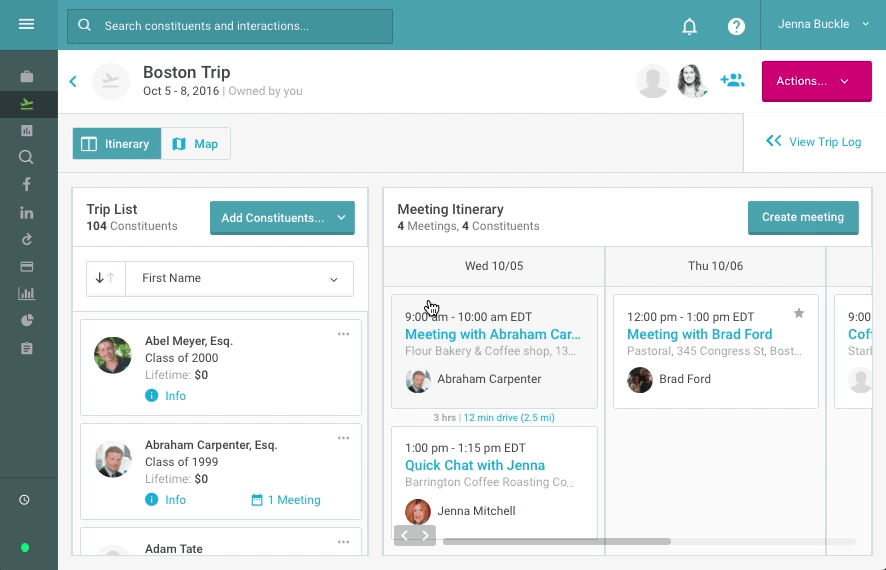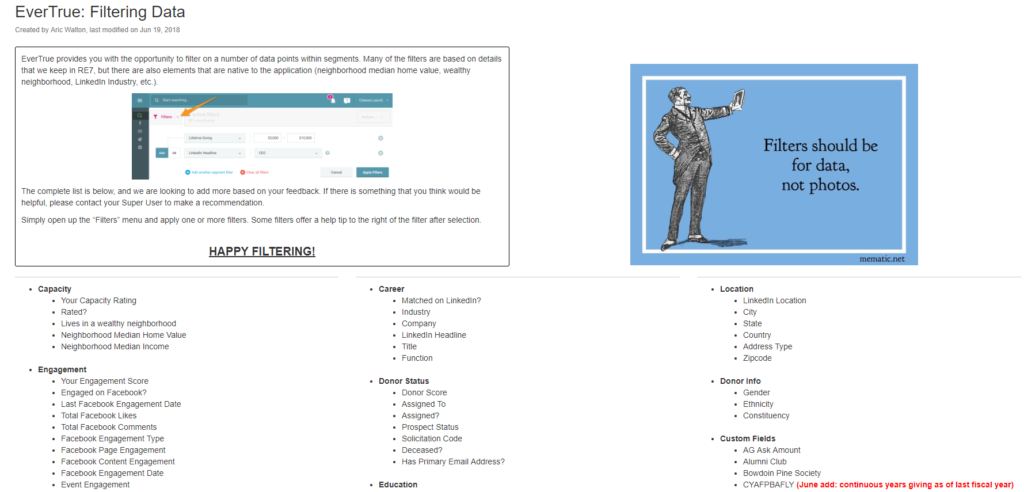Change is difficult.
Think about how hard it is to alter personal habits, whether it’s taking a new route to work, introducing a new cafe to your routine, or sticking to a diet or a workout plan.
Change is even harder for organizations. There’s a LOT of people you need to get on board when you’re kicking off a brand new initiative or adopting new software.
There’s good news though. According to the Harvard Business Review, “Most change is eventually successful, especially when participants are willing to work to make it successful. Just because change is hard doesn’t mean failure is a certainty.”
Yesterday, we hosted a conversation between Aric Walton, AVP for Development and Alumni Relations at Bowdoin College, and Courtney Camps, our VP of Customer Success, on change methodology and creating buy-in across advancement organizations.
(Watch the full webinar on maximizing ROI with EverTrue — or any new software or project.)
Setting the Stage
Aric is EverTrue’s main point of contact at Bowdoin. Among his many responsibilities, Aric is also responsible for the oversight and management of EverTrue on behalf of Bowdoin’s 59 advancement staffers.
Bowdoin first brought EverTrue onboard in 2016, but Aric said the real investment started at the end of 2017.
“We’ve had [fundraising] success in the past,” Aric said. “But when you’re trying to get to the next level, you don’t want to get complacent.”
The Bowdoin team realized that it needed to fully embrace new ways of doing things.
“Every institution should have the guts to be honest. We had to ask ourselves, ‘Did we try? Did we adapt and change to try and get the most out of it?’”
Asking those questions lead Bowdoin to take their relationship with EverTrue to the next level. Here’s how organizations can learn from what they did and get the most out of an investment in technology or changing business practices.
Step 1: Define Success and ROI
Ask your team, “What does success look like?” Start with your eyes on the goal, then figure out how to get there.
If you’re an EverTrue partner, you get to work alongside a dedicated Customer Success Manager to define targets and create the best strategies to hit them.
“I’m talking to Courtney a lot,” Aric said. “For example, the alumni relations team has a goal they want to hit, so we’re talking about how to help them. I can bring those ideas back (and it makes me look better!), but it’s also a nice back and forth. This is a continual relationship that doesn’t stop when you sign the contract.”
Step 2: Connect Goals to Features
Once you have a goal for a new piece of software, you need to determine how you’ll track progress, ideally using that new technology.
If your EverTrue goal is to hit a number of net-new prospects, then add anyone your team discovers to a shared list and keep count (and visibility) that way.
If you want to give teams universal access to constituent information, then make sure they’re all using the mobile apps. At Bowdoin, they upload lists of event attendees to EverTrue and push those out to event staff, keeping information just a tap away.
Bowdoin is also actively seeking more planned gifts. They keep a shared list in EverTrue of unassigned constituents who have indicated interest in a planned gift. When gift officers are traveling and need a filler visit, they can reference that list and book more meetings that way.
Step 3: Define Ownership
While success is everyone’s job, there has to be an ultimate owner of change.
After setting a goal, organizations need to assign ownership to a person who’s responsible for seeing the initiative through, start to finish. That doesn’t mean one person does all the work — it just means there’s someone guiding the whole team toward a shared objective.
That person can then build a group of like-minded change agents who are responsible for their own areas. With software, that means identifying key players for managing data, training users, and defining business rules.
“Bring the two elements of any healthy development shop together,” Aric says. “Get people who are comfortable with technology from the operations team alongside people from the frontline.”
Step 4: Leadership Buy-in is Critical
Having leadership behind you is important for success. Even if the President or CEO of the organization isn’t a power user, having their support gets other teammates on board.
You can also “manage up” by showcasing success from users (more on that later) and regularly reporting on progress toward goals, too.
Communication — even over communication — is key to keep leadership updated, invested, and on your side.
Step 5: Set New Business Rules
Be clear about defining change. What are you doing now? And how should that change with this new tool or access to new information?
For example, prior to using My Trips (trip-planning tools for gift officers), fundraisers at Bowdoin had to look up prospects in Raiser’s Edge to create trip lists, manage those lists in Excel or Word, then track all of their meetings and travel time in their Outlook calendars. They had to use, at a minimum, three pieces of software to execute one trip.
Aric ran a training for Bowdoin gift officers and showed them how they could save time by doing the entire trip-planning process in EverTrue starting with quickly building lists of prospects, dragging and dropping them into an itinerary, and syncing meetings to their calendar.
Now all trip-planning at Bowdoin takes place in EverTrue, letting gift officers spend more time focused on building relationships and less time building itineraries.
But if Aric and the team hadn’t first identified what needed to be changed and shared that information with the team, they’d still be losing time wrestling with multiple systems.

Step 6: Establish a User Group
There’s a 12-person super-user team at Bowdoin with representation from every department. In building this cohort, Aric wanted “internal experts” to set goals, determine new business practices, talk about needs, and see how EverTrue can help.
One of the best things about the user group is that it brings people together who don’t always work side-by-side on a daily basis. They’re busting silos up in Brunswick, Maine!
“It’s fun to tap the people who have never been asked but have been on the team for a while,” said Aric. “When you’re building your own user group, don’t just ask the obvious people.” Draw from the broad spectrum of experience.
Step 7: Share Resources
The Bowdoin advancement team has a wiki — a shared internal website — that documents internal processes and procedures. Think of it as an FAQ or a help site for fundraisers.
There’s an EverTrue section in the wiki that Aric and the user group manages with ideas for searches, links to help.evertrue.com for ideas and best practices, and funny memes and hidden jokes that keep people coming back to read more. They’re not re-creating the wheel or writing documentation from scratch, but they’re sharing helpful content that benefits all Bowdoin staffers.

Step 8: Shout Wins from the Mountaintop
Whether it’s individual stories from the user group or an entire departments hitting a goal, it’s important to constantly celebrate success. As you hit goals, you have the opportunity to showcase the return on investment.
Bowdoin shares updates and success stories internally via email to the entire division, on the resource site, or the user group members take the information back to their respective teams.
When late-adopters see ongoing success, they’re likely to buy into the change as well.
“This doesn’t have to be all the time or self-congratulatory, but it’s important to get people excited and showcase how the work is getting done. Colleague success is a huge motivator,” Aric said.
Final Thoughts
“Change is hard in the same way that it’s hard to finish a marathon. Yes, it requires significant effort. But the fact that it requires effort doesn’t negate the fact that most people who commit to a change initiative will eventually succeed. This point has gone largely unnoticed by an entire generation of experts and laypeople alike. I am just as guilty of this omission as everyone else. But now that we know the truth, don’t we have a duty to act on it? Isn’t it time to change the way we talk about change?” – Harvard Business Review
Change is work. But the effort is worth it.
The world itself is changing every day. If development and alumni relations don’t change with it, the future of the institutions and organizations we support is at stake.
We shouldn’t fear change because change is inevitable; we can play a positive role in that. Don’t be afraid to try something new. Don’t fear failure (just try something new again). And take ownership of doing new things in the best way possible.